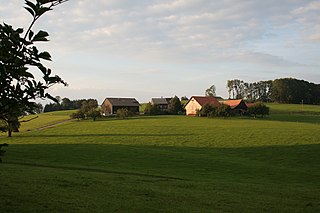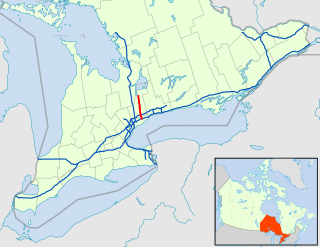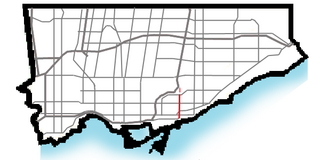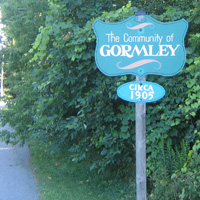Pleasantville | |
|---|---|
Unincorporated community | |
| Coordinates: 44°03′10″N79°24′12″W / 44.05278°N 79.40333°W Coordinates: 44°03′10″N79°24′12″W / 44.05278°N 79.40333°W | |
| Country | Canada |
| Province | Ontario |
| Regional municipality | York Region |
| Town | Whitchurch–Stouffville |
| Amalgamation | (With Village of Stouffville) 1 January 1971 |
| Government | |
| • Type | Municipality |
| • Mayor | Iain Lovatt |
| • Councillor | Ken Ferdinands, Ward 1 |
| Elevation | 290 m (950 ft) |
| Time zone | UTC−5 (EST) |
| • Summer (DST) | UTC−4 (EDT) |
| Forward sortation area | |
| Area code(s) | 905 and 289 |
Pleasantville is a community located in the Town of Whitchurch–Stouffville, Ontario, Canada.

Ontario is one of the 13 provinces and territories of Canada and is located in east-central Canada. It is Canada's most populous province accounting for 38.3 percent of the country's population, and is the second-largest province in total area. Ontario is fourth-largest jurisdiction in total area when the territories of the Northwest Territories and Nunavut are included. It is home to the nation's capital city, Ottawa, and the nation's most populous city, Toronto, which is also Ontario's provincial capital.

Canada is a country in the northern part of North America. Its ten provinces and three territories extend from the Atlantic to the Pacific and northward into the Arctic Ocean, covering 9.98 million square kilometres, making it the world's second-largest country by total area. Canada's southern border with the United States, stretching some 8,891 kilometres (5,525 mi), is the world's longest bi-national land border. Its capital is Ottawa, and its three largest metropolitan areas are Toronto, Montreal, and Vancouver. As a whole, Canada is sparsely populated, the majority of its land area being dominated by forest and tundra. Consequently, its population is highly urbanized, with over 80 percent of its inhabitants concentrated in large and medium-sized cities, with 70% of citizens residing within 100 kilometres (62 mi) of the southern border. Canada's climate varies widely across its vast area, ranging from arctic weather in the north, to hot summers in the southern regions, with four distinct seasons.
It is a small hamlet consisting of mainly farms, residential homes and horse ranches. [1] Pleasantville was originally settled by Quakers from Pennsylvania in the early nineteenth century. [2]

A hamlet is a small human settlement. In different jurisdictions and geographies, hamlets may be the size of a town, village or parish, be considered a smaller settlement or subdivision or satellite entity to a larger settlement. The word and concept of a hamlet have roots in the Anglo-Norman settlement of England, where the old French hamlet came to apply to small human settlements. In British geography, a hamlet is considered smaller than a village and distinctly without a church.

Quakers, also called Friends, are a historically Christian group of religious movements formally known as the Religious Society of Friends, Society of Friends or Friends Church. Members of the various Quaker movements are all generally united in a belief in the ability of each human being to experientially access "the light within", or "that of God in every one".

Pennsylvania, officially the Commonwealth of Pennsylvania, is a state located in the northeastern, Great Lakes and Mid-Atlantic regions of the United States. The Appalachian Mountains run through its middle. The Commonwealth is bordered by Delaware to the southeast, Maryland to the south, West Virginia to the southwest, Ohio to the west, Lake Erie and the Canadian province of Ontario to the northwest, New York to the north, and New Jersey to the east.
Pleasantville is situated east of Highway 404 and can be reached from Vivian Sideroad (Mulock Drive) by driving north on Woodbine Avenue.

King's Highway 404, also known as Highway 404 and colloquially as the 404, is a 400-series highway in the Canadian province of Ontario connecting Highway 401 and the Don Valley Parkway (DVP) in Toronto with East Gwillimbury. The 50.1-kilometre (31.1 mi) controlled-access highway also connects with Highway 407 in Markham. Highway 404 provides access to the eastern edge of Richmond Hill, Aurora and Newmarket and the western edge of Whitchurch-Stouffville, in addition to the southern edge of Keswick.

Woodbine Avenue consists of three north-south road sections in the Greater Toronto Area, Canada:
- The southern section in Toronto begins near Ashbridges Bay on the shore of Lake Ontario, at Lake Shore Boulevard. Woodbine then continues north to O'Connor Drive.
- The middle section in Toronto begins, under the name Woodbine Heights Drive, across the Massey Taylor Creek, in the Parkview Heights neighbourhood. Following the southern alignment of Woodbine, it continues for four blocks and ends at the East Don Valley. Had the alignment of the O'Connor Bridge been north-south instead of southwest-northeast, this section would have been joined with the southern segment.
- The northern section runs from Steeles Avenue at the Toronto-Markham border to the shore of Lake Simcoe, ending at Lake Drive in Georgina.










